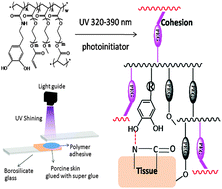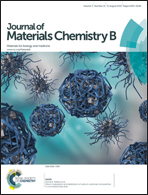On-demand and negative-thermo-swelling tissue adhesive based on highly branched ambivalent PEG–catechol copolymers†
Abstract
A series of well-designed highly branched PEG–catechol based thermo-responsive copolymers were synthesized via a one-pot RAFT polymerization. A varying degree of photocrosslinkable (meth)acrylate moieties were incorporated within the 3D structure to allow on-demand photocuring (strong cohesion, unlike conventional PEG adhesives). At the same time, multitudes of free catechol groups inspired from adhesive proteins of marine mussels were also introduced in the hyperbranched structure, giving rise to adherence to skin and cardiac tissue. The resulting ambivalent PEG–catechol based copolymers were systematically studied to investigate the effects of polymer composition on tissue bioadhesive and swelling properties, comparing acrylates to methacrylates and PEG to 2-hydroxyethyl acrylamide (HEAA). It was proved that DOPA played a major role in the adhesion performance as it significantly enhanced the adhesion performances on varied substrates. The highly branched PEG–catechol copolymers demonstrate the great potential in the design of novel surgical glues, sealants or drug delivery vectors.

- This article is part of the themed collection: 2015 Journal of Materials Chemistry B Hot Papers

 Please wait while we load your content...
Please wait while we load your content...